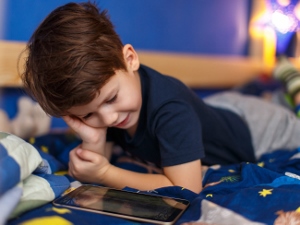

<p><img class=" alignright size-full wp-image-1398" src="http://schoolnewsnz.fastrackdev.com/wp-content/uploads/2015/03/SND14-wk1-Media_survey_300x225.jpg" alt="SND14-wk1-Media survey 300x225" style="margin: 5px; float: right;" width="300" height="225" />A new independent survey of children has found that while TV is still the dominant screen in their lives, tablets and smartphones are now a daily part of most kids&#8217; lives. Youtube is now one of their main sources of content.</p>
<p> <!--more--> </p>
<p>The survey, conducted by Colmar Brunton, was commissioned by NZ On Air and the Broadcasting Standards Authority to provide independent, comprehensive information on the media- consumption behaviour of children today.</p>
<p>The researchers talked to a demographically representative sample of more than 700 children aged six to 14 years old and their parents in late 2014.</p>
<p>The study finds that 88 per cent of this age group watch TV daily, while 66 per cent use the internet and 36 per cent listen to the radio. Use of On demand sites is low with this group at only seven per cent.</p>
<p>The growth of access to and use of mobile devices stands out, with 72 per cent having access to a tablet and 48 per cent access to a smartphone. Overall, internet use has increased 28 per cent since the last survey (2007). The lowest penetration is in low-income households.</p>
<p>Youtube is now the most popular platform for children – 35 per cent access it daily, compared to the most popular TV channel, TV2 at 32 per cent.</p>
<p>The children in the survey strongly preferred cartoons as their favourite type of TV shows, followed by shows with animals and sports. Their parents expressed a strong preference for shows with animals, sports, documentary and information shows, and stories about real New Zealand children and families.</p>
<p>Nine in 10 parents agree it is really important that children are able to watch local shows that reflect them and their world.</p>
<p>&#8220;Local content for children is a key part of NZ On Air&#8217;s mandate. But clearly, what they want and how they want to consume media is changing at pace as technology and platforms evolve. Our challenge is to ensure we are funding what children want, and ensuring it is available where they are consuming media,&#8221; NZ On Air <a class="wpil_keyword_link" href="https://www.schoolnews.co.nz/2015/10/new-chief-executive-for-education-council/" title="chief executive" data-wpil-keyword-link="linked" target="_blank">chief executive</a> Jane Wrightson says.</p>
<p>NZ On Air will now be using the research to review its children&#8217;s strategy and consult with content-makers and broadcasters.</p>
<p>&#8220;As we mark 25 years of funding local content, we know that we must always keep pace with change. With so many global options for content now accessible by children it is vital they continue to see and hear themselves and their world reflected in the media, to have a sense of national identity,&#8221; Ms Wrightson says.</p>
<p>The full report is available at <strong><a href="http://www.nzonair.govt.nz/research/" target="_blank">www.nzonair.govt.nz/research/</a> ;</strong></p>

EXCLUSIVE: Teachers used to be paid two to three times more than minimum wage workers,…
After an “overwhelming” vote to reject the latest Government offer, secondary school teachers will begin…
Second-language learning should be compulsory, says a new report from a forum bringing together academics,…
A new entitlement aimed to improve access to learning support coordinators for schools with students…
Educators have raised questions about the Ministry of Education’s new secondary school subjects, set to…
Professional learning and development (PLD) for teachers needs to be higher impact for teachers and…
This website uses cookies.